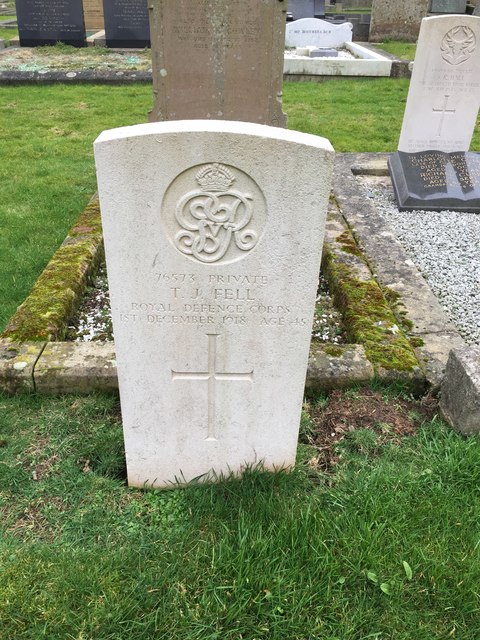SC2482 : 76573 Private T J Fell headstone
taken 4 years ago, near to Patrick, Isle of Man

The inscription reads: Royal Defence Corps, died 1st December 1918 aged 45.
His Soldiers Effects states he died in Knockaloe Hospital I.O.M and served with the 315 Protection Corps.
Apparently he died of pneumonia.
During research the following has emerged:
He was the eldest son of the late William Fell (a seed merchant and with whom he worked for a time) of Hexham-on-Tyne. He came from Buenos Aires, South America, to serve.
At one time he was enlisted as part of the RAMC and retained his service number being transferred to the Royal Defence Corps at a later stage.
The Royal Defence Corps was introduced by a Royal Warrant of 17 March 1916 and promulgated by Army Order 115 of 19 March 1916.
“To carry out duties connected with the local defence of the United Kingdom, including those hitherto performed by the Supernumerary Territorial Force Companies, as well as those allotted to the Observer Companies now in process of formation“.
The Royal Defence Corps was a corps of the British Army formed in March 1916 and disbanded in 1936.
It was initially formed by converting the (Home Service) Garrison battalions of line infantry regiments. Garrison battalions were composed of soldiers either too old or medically unfit for active front-line service; the Home Service status indicated they were unable to be transferred overseas.
The role of the corps was to provide troops for security and guard duties inside the United Kingdom; guarding important locations such as ports or bridges. It also provided independent companies for guarding prisoner-of-war camps.
The RDC would consist of two types of unit:
1. Protection Companies. They would take over the duties of the Supernumerary Territorial Force Companies and would come into existence on 29 April 1916. While it was expected that the number of such units would vary across the army’s geographical command areas, company numbers were issued in blocks of 50.
Protection Companies 1-50 would be for Lines of Communication Companies.
Protection Companies 51-100 would be for Eastern Command.
Protection Companies 101-150 would be for London District
Protection Companies 151-200 would be for Northern Command
Protection Companies 201-250 would be for Scottish Command
Protection Companies 251-300 would be for Southern Command
Protection Companies 301-350 would be for Western Command.
Any Protection Companies required that were outside this structure would be numbered 351 and upwards
2. Observer Companies. They would be numbered consecutively in their own sequence, starting from 1.
In April 1918 some 27,000 men were serving in the RDC. Of these, 14,000 were employed at prisoner of war camps.
On 5 August 1914, the day after World War I broke out, the British Government passed the Aliens Restrictions Act, whereby the British Government could control the movement of “enemy aliens”. General internment of all Germans of military age began in May 1915 following the sinking of the “Lusitania”.
The first 200 internees arrived on the Isle of Man in September 1914 for internment in Cunninghams Camp, Douglas. However, there was a riot in Douglas camp leading to the death of 5 internees due to overcrowding and the poor quality of the food. Knockaloe Moar farm, a former training camp for Territorial troops, was identified as and eventually became the largest internment camp of WWI.
The first of the civilian male internees arrived on 17 November 1914 and ultimately the internees were of various nationalities including German, Austrian and Turkish.
One of the most famous internees was Joseph Hubertus Pilates who pioneered the world famous exercise and fitness foundation.
Knockaloe Camp ultimately held “nearly 24,000 prisoners in 23 compounds inside barbed wire, with 4,000 old soldiers acting as armed National Guard, and 250 civilians attending to their wants and comforts… The camp at Knockaloe was three miles in circumference; 695 miles of barbed wire surrounded the compounds”
At one time it had its own railway running from Peel via Raggatt to the old schoolhouse (now the museum) crossing the road and following the main driveway right up through the middle of the Camp. The 1 mile and 6 chains long Knockaloe railway line was funded by the British Government and was in use from September 1915 for 5 years. Only the engine house remains. One of the main locomotives used was number 15 Caledonia now restored and running on IOMSR.
The camp closed in 1919 and was demolished; the concrete lintels and blocks now form the wall to the main driveway.
There were 207 German interned civilians buried on the Isle of Man during WW1 in both Douglas Cemetery and Kirk Patrick (St Patrick) Churchyard. They came from the camp at Knockaloe.
All the Germans bar one were exhumed and reburied in Cannock Chase German Military Cemetery, Staffordshire in 1960/61 along with the majority (not all) of German casualties in the UK from WWI and WWII.
A considerable number of guards are also buried in the churchyard along with two Jewish graves and seven Turkish internees.
Knockaloe Farm is currently owned by the IOM Department of Environment, Food and Agriculture.
Part of this was taken from Linkwhere more information can be found.
